Many times I’ve been asked how I sign my fine art prints, and having received an email recently from listener Tanya Mattson from Pennsylvania, USA, I decided to go into a little bit of detail on this in today’s episode. Apparently Tanya and her husband had watched the video I released recently showing the lamination process for Breathing Color Lyve Canvas, and during the intro I signed the canvas print that I would be laminating, and it was watching this that triggered the question.
So, firstly thanks for watching the video Tanya, and thanks for the question. Tanya had asked for details of the pens that I used, and also if they were archival, so let’s touch on these areas in turn.
I have tried many pens over the years, and right now I use a variety of pens depending on the paper and purpose.
The pen that I’ve used the most and I still use sometimes is a photo signing pen from Sakura Color Products Corporation. I use this still for some matte prints, but it’s a good pen for signing gloss prints especially. It’s basically a felt-tip pen, with a large and a fine tip, on either end of the pen. I quickly took some photos to show you, and I’ll put these images into the blog post and the Enhance Podcast, so you’ll be able to see them on your iPhone or iPod, or go to my blog if you are listening at your computer.
Although pretty good for signing gloss prints, the problem I found with felt-tip pens like this is that the tips can be relatively dry, which leads to the signature looking patchy when signing matte paper like the Hahnemühle Photo Rag or textured papers like their Museum Etching fine art paper. Another option for signing matte papers, and these are archival too of course, is a good old pencil. Pencils are good for signing in the border of a matte print, but don’t work so well when you have to sign over the photograph itself, unless it’s very pale and you use a relatively soft pencil. The problem with softer pencils though is that they can smudge easily, so not the best idea.
The other pen to the left of the photo signing pen in the photo is also from Sakura Color Products Corporation, and this is another felt-tip, but is a pigment based pen, so it certainly feels better to use on archival quality fine art prints. I have three of these in different thicknesses. A very fine one, for signing small prints, and in the same vein, a medium one for medium sized prints and a pretty wide tipped one for large prints. It doesn’t look great to sign with a great bit fat pen if your print is only pretty small. The signature starts to carry too much weight in my opinion if it’s too thickly written. The same problem happens with these Pigma Graphic pens though, in that they tend to be a little on the dry side for signing fine art matte paper.
For my matte prints, and also for the canvases that I’ve recently started doing, I’ve settled on a pigment based gel ink range of pens from Mitsubishi, under the name Uni-ball Signo. These don’t have the problem where they dry up while writing, even on matte papers, and they push out enough ink to be able to easily write on heavily textured canvas, as you will have seen in the video that I released as episode 164, in which I showed you the Breathing Color Lyve Canvas lamination process.
As for whether or not these gel pens are archival, I’ve never been able to find conclusive evidence that they are, but I have found numerous forums and artists web sites discussing people using them, and have not been able to find any threads discussing them discoloring or hurting the paper in any way. Now, of course, this is unlikely to happen straight away, but also helping me to make up my decision to use these pens is the fact that I actually bought a set of these pens in various colors for signing prints some seven years ago, and I still have some old prints signed with the same pens from that time, and they haven’t altered at all with time.
The ink in the original set of pens did dry up though, so when I was looking for a pen to sign my new gallery canvas prints recently, I had to buy some more, but on searching for pigment gel ink pens, I ended up at the exact same make and model that I’d bought seven years ago, so I checked my old prints, found no problems, and went with these pens. Seven years might not be a long time in the scheme of things, but I’m pretty happy to bet that they will not show any problems over the long term.
I didn’t buy a whole range of colors this time, as my original idea of using a color that complimented the print went out of favor in my mind after the initial thought. What I did buy though is the three colors that we can see in the photo here, which is black, silver and white.
Black is my default color for most prints, as it’s understated and doesn’t scream for attention. This is the color that I used to sign the print that I showed in the video in episode 164, and I have also started using this to sign in the border of matte fine art prints, as we can see here.
The white pen is great for signing on black or in very dark corners of prints, as we can see in this next photo, which is the corner of a canvas print for my December exhibition here in Tokyo.
I also bought a silver pen, but in reality, it’s a nice light to mid-tone grey, which I’ve started using for some black and white prints, like the long exposure of the Towada Lake with the wooden jetty that we see here. These pigment gel pens are only $1.50 so I figured I’d pick one up, and I think it looks quite good on the darker grey. Again, I want the signature to be noticeable, but not scream my name out to people, and so the three colors that I have right now seem like a good range to have.
I’m not sure if these can be bought outside of Japan with the same name but as I say, my pens are from Mitsubishi and they are called Uni-ball Signo. The part number for the black is UM-153 .24. The .24 seems to indicates the color. The white pen has a .1 on it and the silver pen is .26. I also have a UM-151 .24 which is a fine tip black for smaller prints. I haven’t yet been able to find a medium tip, but I’m keeping my eye out for these, to complete my range. Note though that as I said earlier, these same pens that I bought some seven years ago dried up while I wasn’t using them, so you probably don’t want to go crazy and buy a whole range of these, unless you are going to be using them regularly.
Tanya also mentioned in her mail that the gel pens she’d found tend to leak too much ink, so I did just want to mention that I haven’t noticed these pens leak as such, though they do put out a lot of ink once you start writing. I find this a benefit when signing matte prints or the canvas, as I mentioned earlier, but another trick that I use is to always keep a piece of canvas or matte paper hanging around to do a practice signature before I actually sign the print. This not only helps to condition the pen before signing a full sized print, but it also helps me to write my signature more smoothly. When you’ve just printed out a 24×36 inch canvas, costing around $17 just for materials, the last thing you want to do ruin it with a messed up signature, and believe me, I’ve come close a few times. I always get nervous when I’m signing prints, so the little practice beforehand really helps.
Before we finish, I did also just want to touch on that age old question of whether or not to actually sign the prints in the first place. Well, for my December Exhibition, I am going to be signing all of the canvas wraps, because I really have to sign them before I laminate them, so that the signature is locked in there, as part of the piece.
I’m still undecided as to whether to sign my Hahnemühle Photo Rag and Museum Etching fine art prints, as these can easily be signed afterwards, and I generally like to give the customer the option of having me sign it or not. Now, I am going to add that I personally would prefer to sign my prints. I’d like to think that my name will be carried with the print, and I’d also like to think that anyone that was willing to part with good money to own one of my prints, would also like it signed. Even on my Web site, where people can order prints, I have the signature as an option that can be turned off, but in practice, I don’t recall anyone ever actually ordering a print that didn’t want it signing. I guess with this in mind, and the fact that I personally would prefer to sign them, making this an option is more of a statement of modesty than anything else.
I probably should also let you know before we finish that the signature that I use to sign my prints is not my everyday signature. I’m sure if someone was to analyze this signature they’d say that the huge underlining was a display of over confidence or conceitedness. To be honest, that’s totally intentional. I think that the very act of putting artwork out there for viewing and more important for purchase requires confidence, and a certain amount of “look at me”. With that in mind, when I started to sign my prints, I created this new signature just for that purpose, and I think that’s perfectly OK.
There is also the question of whether to sign over the image, in the border, or even on the matte. Again, I vary what I do depending on the work. For canvas wraps, there is no border, so I find an area of the bottom right corner to sign. For fine art prints with a border, I generally sign in the border, but again, I make this an option when purchasing the print. If the client wants to frame right up to the edge of the printed area, I have no problem with signing over the photo itself. I have also signed the matte, but when I sign the matte, I also like to sign the back of the piece with a pencil, in case the matte is changed at any point in the future.
I would also like to add that I always include an insert with my prints, telling the user when and where the image was taken, and on what printer and paper it was printed, and with what inks. Whether this is totally necessary is up to you, but I think if nothing else it makes the presentation more professional. For framed pieces, these inserts will be dropped into the back of the frame, to save them getting lost, unless they are intentionally removed of course.
Podcast show-notes:
Music from Music Alley: http://www.musicalley.com/
Audio
Download the Enhanced Podcast M4A files directly.

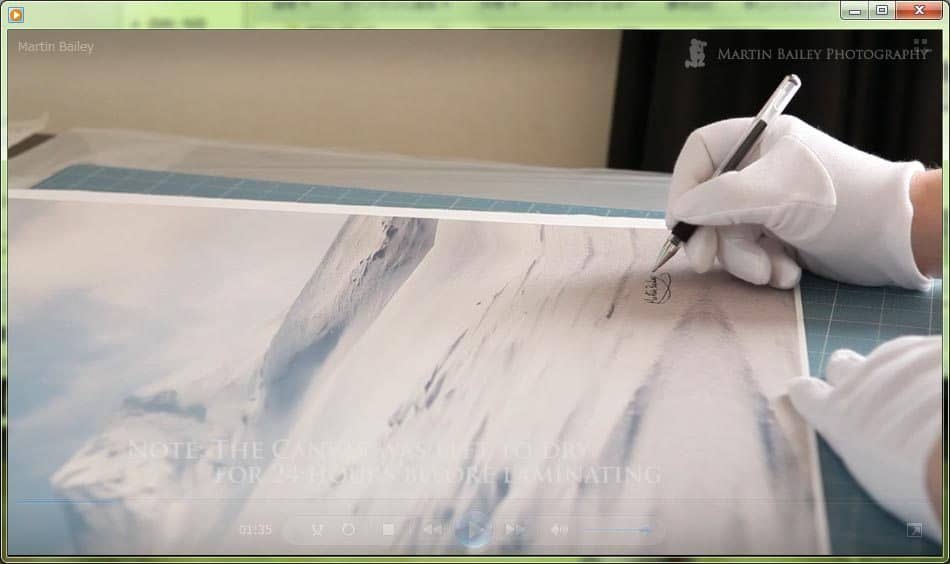
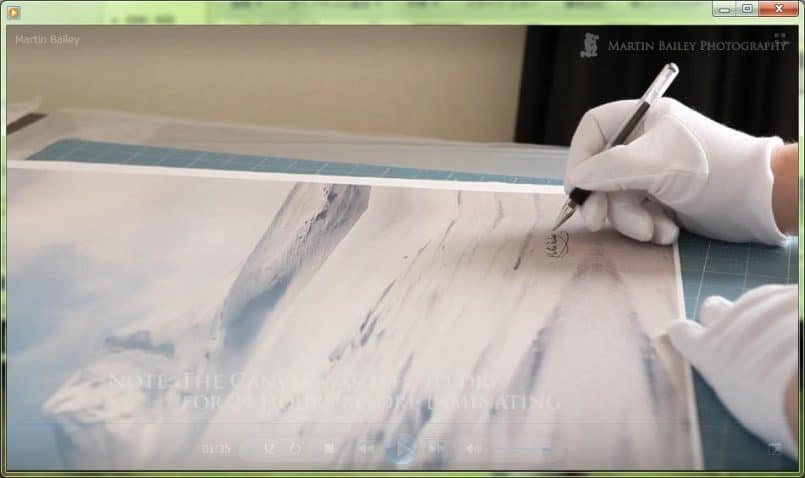
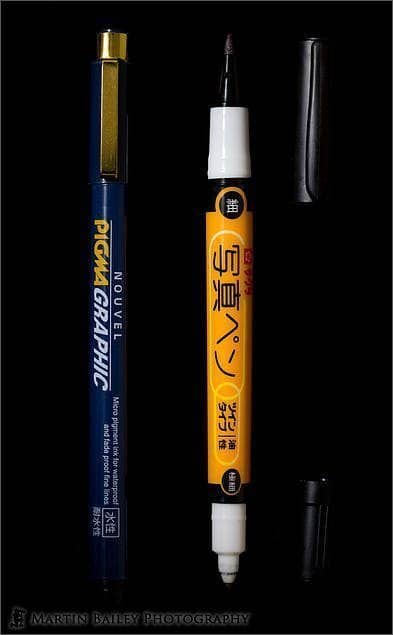

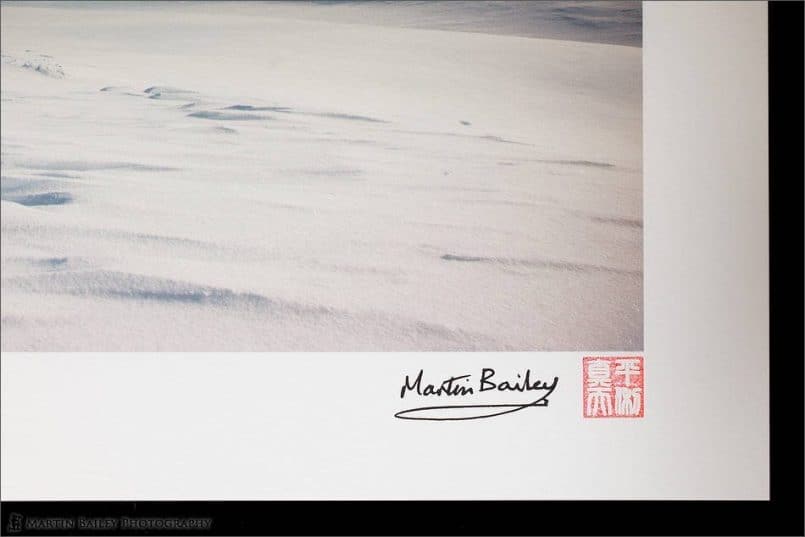
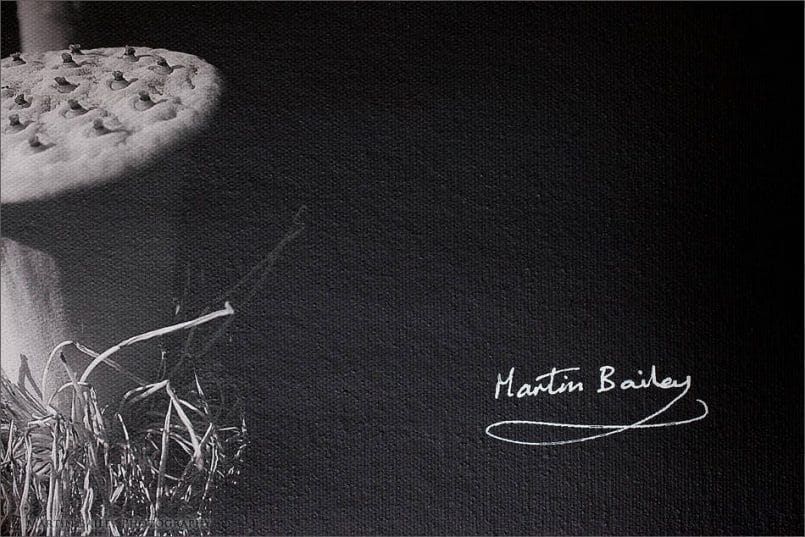
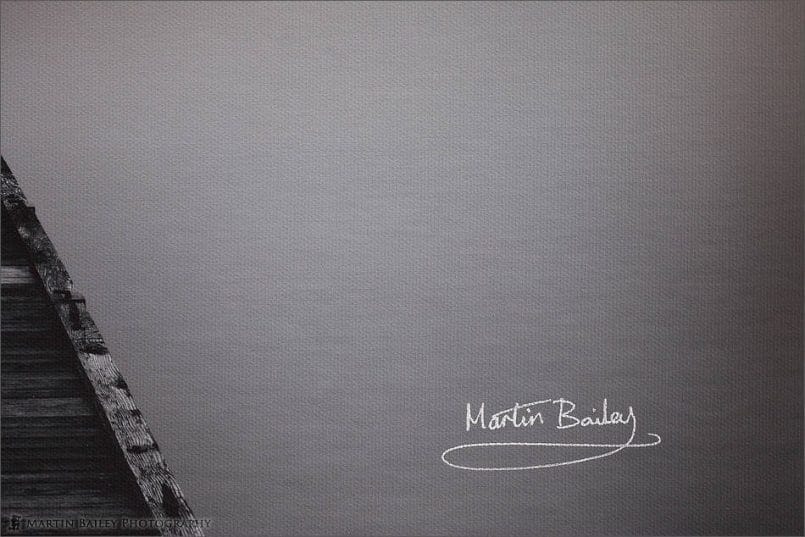
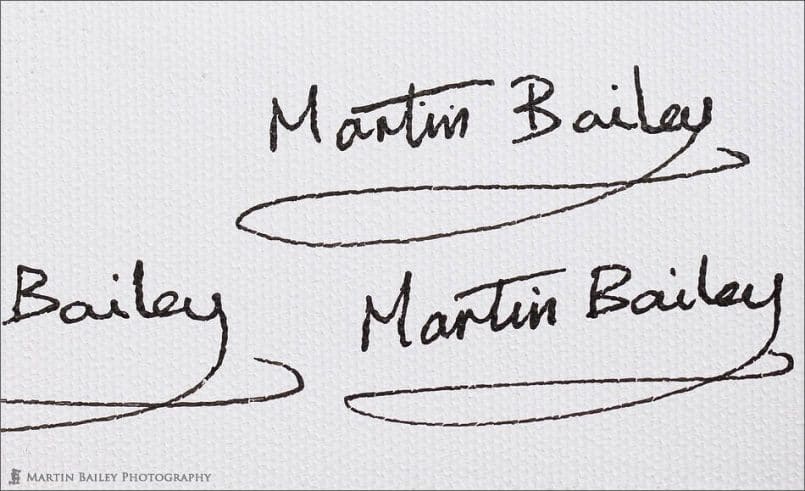

Thanks Martin, this is great information. I didn’t sign my recent prints that were installed in a medical building because I didn’t have this info…next time I will sign them!
Martin – Just discovered your podcast and am in the process of catching up. I’m having a great time and learning a lot.
For folks looking to purchase these pens, I have found them at jetpens.
http://www.jetpens.com/index.php/product/view?products_id=1203
thanks again for all the great information and most of all, Good luck with your Exhibition !
david
Thanks for the great post. You headed me in the right direction. There seems to be little information on the subject. Thanks David Jenne for the link. I can’t find them in Edmonton so I will order them from your link. I did find some Sakura micron ink pens which I tested out last night. They still smudge a bit on the paper after drying for a bit. Martin, did you have to leave the signature to dry for a long time when using it on glossy surfaces? I am using the felt tip micron pen from Sakura’s on Ilford Gold Fibre Silk.
Thanks,
Charlie
Hi Charlie,
I never noticed any smudging, but then the only time I rub them is when testing, as you are now. Also, I use mostly matte papers, and they definitely soak up the ink more than gloss will. I would suggest waiting a while after signing, and see if it smudges then.
Cheers,
Martin.
Thanks Martin 🙂
Hi Martin, great information and beautiful work. I sell prints online, but have my printing company drop ship direct to the customer. I would be interested to hear your thoughts on adding a digitized signature to the image, so the “signed” copy goes straight out to the customer. Is that cheating? BTW, mine are all open editions.
Cheers,
Adam
Hi Adam,
Thanks for taking a look, and for the kind words.
Digitally signing really depends on how you position your prints. There are no hard and fast rules, but an “original print” made and signed by the artist is generally more expensive and more collectable, so you should really make it understood that your prints are printed by a third party and not individually signed by yourself. As long as you are upfront about this, I don’t think there’s anything wrong in what you are considering.
Cheers,
Martin.
Thanks! I appreciate your insight.
I have been looking for pens to sign photographs that I have printed on canvas. It has not been easy to find any information on internet. The best information was on your page. Thanks for sharing your experience! Do you know if it is common to write number of prints below the signature? To me it looks better to only have the signature, but the numbering has to be somewhere. Do you have a link to those three pens that you used for the canvas? The silver, white and black? I have some prints that are very white. Maybe the silver would be good. I dont want to “destroy” the peace in the picture. Thanks again, Martin!
Do you think these are the same pens? http://www.amazon.com/Uni-Medium-1-0mm-gold-Silver-Ink-value/dp/B00G1YFBA8/ref=pd_sim_op_4?ie=UTF8&refRID=0014QD5PH5YWWSH4FBV9
Yes, there isn’t a lot about this on the Internet Heidi. The pens you found (and linked to) are the 0.5mm tips, which I use for smaller gallery wraps. For my large gallery wraps I use these: http://www.amazon.com/Uni-ball-Signo-Broad-UM-153-Gel/dp/B001GR6BVI/ref=sr_1_2?ie=UTF8&qid=1407492424&sr=8-2&keywords=um-153
If you search for UM-153, you can find the other colors too.
I actually don’t number my prints, but if I did I would probably do it on the back, with a finer pen or even pencil.
I hope this helps!
Thank you so much! It helps a lot! 🙂 Have a wonderful weekend!
You too Heidi!
Do the uniball signo pens write properly on canvases that are already laminated?
I think I’ve done that once Donalda, and it works, although I generally prefer to sign before laminating, to fully bond the signature with the canvas.
I just started making canvases with my photos for sale at a local venue. But I don’t see them until they are laminated. This has been the most helpful information regarding signature. Thank you. Now to find these pens.
I see. It should be fine.
BTW, there is a link to the pens on Amazon in an earlier post above.
I was wondering your thoughts on signing a canvas print after it was laminated? I have done that a few times with the Sakura Pen Touch and it seems ok and has held up on some older prints I still have hanging around. But, I have not tried a white pen on top of the laminate and wondered if you had a recommendation on this.
It’s a tough one Judy. I have only used the white pen on canvas before laminating it. They’re good pens, so it will probably be OK, but definitely preferable to do it before laminating if possible. If that’s not possible it would be good to do a test and at least check that the ink dries OK and does not come away with a bit of rubbing after a few days.
Hi Martin, found this googling around for advice on fine art prints which I am on the point of embarking on. My handwritten signature is an undecipherable scribble. Would it be okay to use a digital signature from photologo.co embedded in the digital file and therefore printed (and also not my real signature) for a fine art print and possible a limited run print? Would this be considered a little ‘mass production’. The advantage of it is consistency and neatness plus I don’t have to visit a print shop to sign the print before it is framed? As always your thoughts would be valued. Cheers mate.
Hi Morden,
Personally, I feel if you are selling the image as an “original” fine art print, it should be personally signed, to prove that you actually printed it. Otherwise, an embedded digital signature could be printed by anyone, anywhere, and therefore would not be an “original”.
Whether it’s. still a fine art print or not is debatable, but you could leave it up to your customers to decide. If people buy it anyway, they don’t care. I don’t think you’d get any collectors or art buyers buying your prints with a digital embedded signature though. I guess it’s up to you.
For a limited run, I really think you should be signing yourself. I also personally think you should be printing yourself too, rather than outsourcing that. If you outsource it, the concept of doing a limited run has almost no value, in my humble opinion. It’s totally up to you of course, but at the very least, you should make it known to your customers beforehand that they are not personally signed.
As a final bit of food for thought, if I had the opportunity to buy a limited edition print from a photographer that I admired and found that it was not personally signed, I would not buy it. It just doesn’t feel right to me.
Sorry I couldn’t give you a more positive answer, but that’s my honest take on it.
Cheers,
Martin.
Thanks for the advice Martin, food for thought. I don’t have a printer big enough to do the large prints I hope to sell so printing myself is not a viable option at least for prints larger than A2 (I have an ipf5100). Guess I’ll have to work on my signature! Thanks again for all the valuable info you put out – I’m reading your printing ebook again at the moment:)
Hi Morden,
I see. Then you might want to still consider the outsourced prints, and even with the digital signature if it makes life easier, but be careful how you position them. I definitely wouldn’t do a limited edition on them.
You’re welcome for the content, and thanks for reading my ebook again! 🙂
Cheers,
Martin.